workname: Tele Echo Tube: beyond Cultural and Imaginable Boundaries
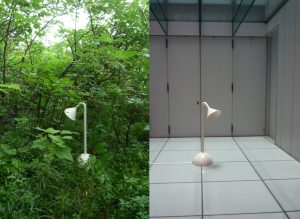
abstract:
Tele Echo Tube (TET) is a speaking tube installation that acoustically interacts with a deep mountain echo through the lampshade-like interface. TET consists of remote and local speaking tube systems with one-way echo canceller through a full duplex audio pipe over the globe. The remote and local systems with an identical appearance, perform a remote interaction to create an ECHO sounding and experience with Japanese ECHO (Mountain Nymph in Greek mythology), located 1,200 m above sea level. The remote tube, consisting of weather-resistant microphones and speakers, is placed in an uninhabited mountain forest at Cyberforest project site in The University of Tokyo Forests (35°94’N,138°80’E). The remote tube continuously captures and transfers the live sound to the local tube in real time through a communication satellite (LS-1300 SX) at 36,000 km altitude. The songs of small birds, the trickling of a stream, and the sounds of insects moving about in the forest represent the diversity of organisms on the forest. To interact with the ECHO, users can sing out “YO-HOOOOO!” very lively from the local tube to the speakers in the remote forest. A loopback call at the remote tube occurs while the playback sound from the speaker is captured by the mics and transferred to the local tube with spontaneous network delays (approx. 20-90 secs). When the users hear the loopback call, “their voices within the soundscape from the forest”, they cognize that the aural expression actually traveled through the forest. This loop, which pipes live sounds from the remote and local sites, creates an ECHO sounding effect. In doing so, TET gives the users an opportunity to feel the presence of “a fickle ECHO in the forest” in the midst of a city, beyond cultural and imaginable boundaries. (detail PDF)
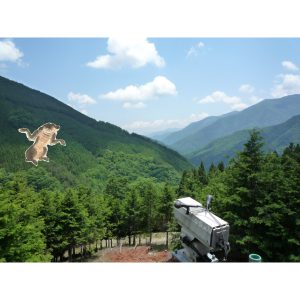
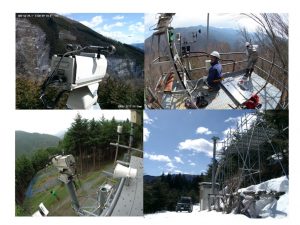
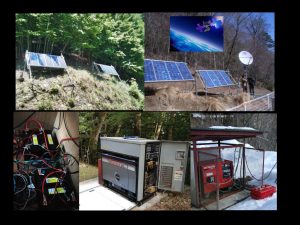
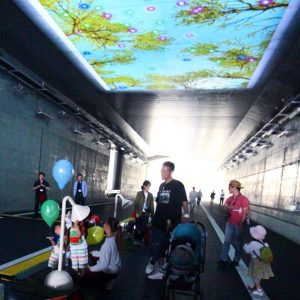
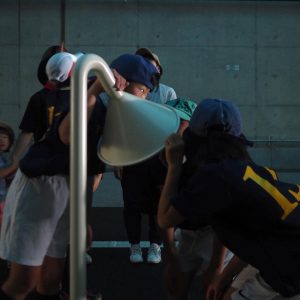
Artist Statement :
A comparable type of complex presence existed in Japanese culture. For cultural and mythological reasons, in ancient times, interactions between nature and human societies were more balanced than the interactions that characterize modern society. Before human beings became capable of dramatically altering natural landscapes, humanity and nature were physically separated but spiritually and emotionally connected. Although Japanese farmers interacted with nature in their local environment, the mountainous wilderness areas of Japan were considered to be the domain of gods and mythological creatures. Consequently, wild animals and their habitats in the mountains were left undisturbed for the most part, and Japanese culture was characterized by respectful and benevolent interaction between nature and humanity. Recent technological and information advancements, including satellite imaging, have been unable to confirm the presence of mythological creatures in undeveloped natural locations, and very few humans now believe in the existence of the creatures that control the weather or other farming conditions. However, because we no longer embrace the presence of such cultural and imaginable metaphors in our daily lives, especially in city life, there has been little outcry at the severe materialism brought about by the globalization process. Tele Echo Tube (TET) aims to increase the mythological awareness in the midst of a modern city beyond our cultural and imaginable boundaries. It is a speaking tube installation that acoustically interacts with a deep mountain ECHO through a networked remote-controlled speaker and microphone. It allows users to interact with the ECHO in a sanctuary forest in real time through an augmented echo-sounding experience. In doing so, TET would help us design an interactive system that leverages the boundary of the real and virtual worlds by engaging a culturally cognition to perform a nonhuman-centric interaction with a culturally imaginable creature.
Exhibition and Awards:
- Winner, Installation art, London International Creative Competition, UK, 2019.
- Exhibition For A Possible Future, The National Art Center, Tokyo, Japan, 2018.
-
Matsudo International Science Art Festival, Chiba, Japan, 2018.
- Tokyo Gaikan Expressway Event, Chiba, Japan, 2018.
- Winner, Interface and Interaction Design Category, A’ Design Award, Italia, 2018.
- Accepted for 10th Arte Laguna Prize exhibition, Venice, Italia, 2016.
- Encouragement Prize, Telecommunications Advancement Foundation-TELECOM System Technology Award, Tokyo, Japan, 2015.
- Accepted for ACM TEI art exhibition, Stanford, USA, 2015.
- Animals in the Dark Night Exhibition, Gunma Museum of Natural History, Gunma, Japan, 2014.
- Accepted for ACM MULTIMEDIA art exhibition, Barcelona, Spain, 2013.
- (E)scapes: exploring the sonic relationship between body and space, NAISA Space, Toronto, Canada, 2013.
- BASAL Exhibition, Museo Universitario de Arte Contemporáneo (MUAC), Mexico city, Mexico, 2010.
- Artech Exhibition, ASIAGRAPH, National Museum of Emerging Science and Innovation, Tokyo, Japan, 2008.
Research Papers:
- Hiroki Kobayashi, Michitaka Hirose, Akio Fujiwara, Kazuhiko Nakamura, Kaoru Sezaki and Kaoru Saito. Tele Echo Tube: Beyond Cultural and Imaginable Boundaries. In Proceedings of the 21th international conference ACM International Conference on Multimedia (ACM MM ’13) , Barcelona, Spain, Oct 21-Oct 25, 2013. (doi:10.1145/2502081.2502125)
- Hill Hiroki Kobayashi. TELE ECHO TUBE. LEONARDO / Journal of the International Society for the Arts, Sciences and Technology (MIT Press), pp. 484-485, 2013. (doi:10.1162/LEON_a_00647)